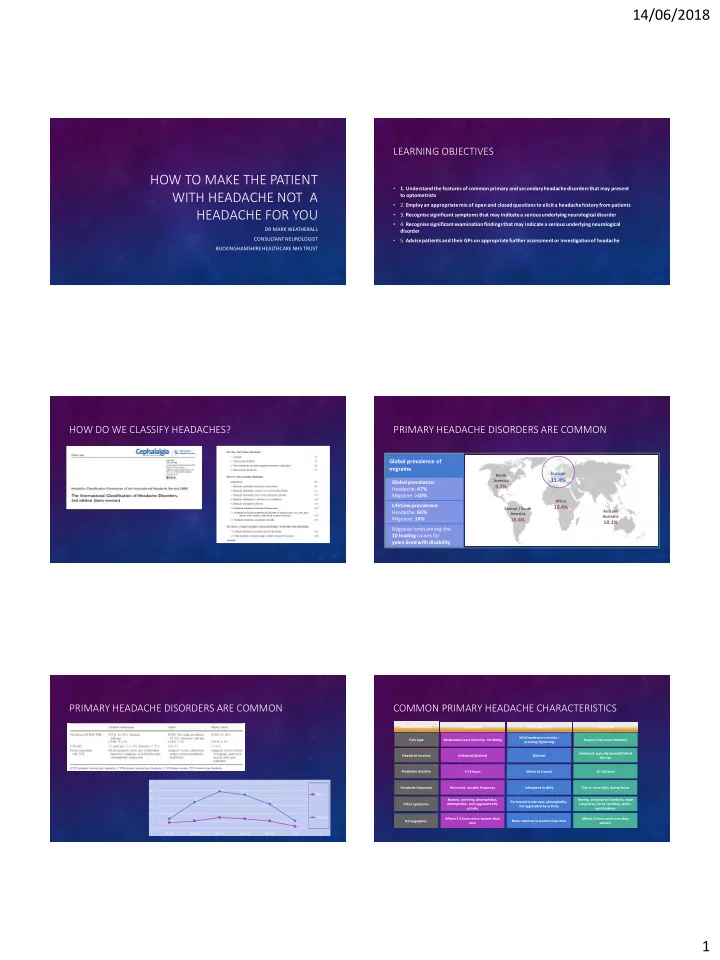

14/06/2018 LEARNING OBJECTIVES HOW TO MAKE THE PATIENT • 1. Understand the features of common primary and secondary headache disorders that may present WITH HEADACHE NOT A to optometrists • 2. Employ an appropriate mix of open and closed questions to elicit a headache history from patients HEADACHE FOR YOU • 3. Recognise significant symptoms that may indicate a serious underlying neurological disorder • 4. Recognise significant examination findings that may indicate a serious underlying neurological DR MARK WEATHERALL disorder CONSULTANT NEUROLOGIST • 5. Advise patients and their GPs on appropriate further assessment or investigation of headache BUCKINGHAMSHIRE HEALTHCARE NHS TRUST HOW DO WE CLASSIFY HEADACHES? PRIMARY HEADACHE DISORDERS ARE COMMON Global prevalence of migraine Europe North 11.4% Global prevalence: America 9.7% Headache: 47% Migraine: >10% Africa Lifetime prevalence: 10.4% Central / South Asia and Headache: 66% America Australia Migraine: 14% 16.4% 10.1% Migraine ranks among the 10 leading causes for years lived with disability PRIMARY HEADACHE DISORDERS ARE COMMON COMMON PRIMARY HEADACHE CHARACTERISTICS CHARACTERISTICS MIGRAINE TENSION-TYPE CLUSTER Mild/moderate intensity – Pain type Moderate/severe intensity - throbbing Severe/very severe intensity pressing/tightening Unilateral, typically around/behind Headache location Unilateral/bilateral Bilateral the eye Headache duration 4-72 hours 30min to 1 week 15-180 mins 30 Headache frequency Recurrent, variable frequency Infrequent to daily One or more daily during bouts 24.4 25 22.2 Men 20 17.3 Nausea, vomiting, phonophobia, Tearing, conjunctival injection, nasal 16 Pericranial tenderness, phonophobia, Other symptoms photophobia, pain aggravated by congestion, facial sweating, ptosis, 15 not aggravated by activity activity eyelid edema 10 6.4 7.4 5 6.5 5 Women 5 Affects 2-3 times more women than Affects 3 times more men than 5 4 Demographics More common in women than men men women 1.6 0 12 – 17 18 – 29 30 – 39 40 – 49 50 – 59 >60 1
14/06/2018 MOST DISABLING HEADACHES ARE MIGRAINES MIGRAINE = HEADACHE PLUS • ‘migraine’ is the disorder and the attack • this is analogous to epilepsy: the disorder (epilepsy) is a tendency to the attacks (seizures/fits) • In migraine both share the same name • the disorder is characterised by: • the tendency to repeated attacks • triggers (sleep, food, weather, chemical (EtOH, GTN), hormonal, sensory, stress/relaxation • certain associations (hangovers, motion sickness, childhood vomiting) • family history IS IT MIGRAINE OR TENSION-TYPE HEADACHE? IS IT MIGRAINE OR CLUSTER HEADACHE? • recurrent disabling headaches are migraines until proven otherwise • • look at the pattern of attacks: people do not get >1 migraine attack/day ask about the worst type of attack • • migraine rarely wakes people from sleep the SPECTRUM study showed that in patients whose worst headache fulfilled the criteria for migraine, all their headaches (however mild/severe) responded to triptans, whereas those with purely TTH did not • autonomic symptoms are seen in people with migraine attacks, but are rarely as prominent as they • TTH rarely stops people doing what they want to do are in cluster headache and related conditions • TTH is not associated with nausea or light sensivitity • cluster patients are restless & agitated; migraine patients want to keep still & quiet • chronic TTH is rare A BASIC SET OF QUESTIONS • How did your headaches start (suddenly/gradually/always had them)? • How long do your headaches last (minutes/hours/days)? • Where do you feel the pain (same place every time/different places)? • Do you get more than one attack in a day? • Do you experience nausea or worsening of the pain with exposure to normal levels of light? • What do you do when you get the pain (be still & quiet/pace restlessly)? 2
14/06/2018 ‘RED FLAGS’: NICE GUIDELINES 2015 SERIOUS CAUSES OF HEADACHE • worsening headache with fever ; sudden-onset headache reaching maximum intensity within 5 minutes; new-onset neurological deficit; new-onset cognitive dysfunction; change in personality; impaired level of consciousness; recent (typically within the past 3 months) head trauma; headache triggered by cough, Valsalva (trying to breathe out with nose and mouth blocked) or sneeze; headache triggered by exercise; orthostatic headache (headache that changes with posture); symptoms suggestive of giant cell arteritis; symptoms and signs of acute narrow angle glaucoma; a substantial change in the characteristics of their headache WHEN TO WORRY ABOUT HEADACHES: HISTORY WHEN TO WORRY ABOUT HEADACHES: EXAMINATION • Thunderclap headache (subarachnoid haemorrhage) • Headache with focal neurology (brain lesion) • Persistent worsening headache (meningitis, brain lesion, raised ICP) • Episodic headaches brought on by manoeuvres that raise intracranial pressure (raised ICP, colloid cyst) • coughing, sneezing, straining • Headache associated with a red eye and impaired visual acuity (acute angle-closure glaucoma) • New headaches in anyone > 55 years (giant cell arteritis) 2 THINGS TO RECOGNISE: 1. MIGRAINE AURA 2 THINGS TO RECOGNISE: 2. VISUAL SNOW 3
14/06/2018 WHAT TO TELL THE PATIENT AND THE GP THANK YOU • if papilloedema, URGENT REFERRAL within 24 hours • if acute glaucoma, URGENT REFERRAL within 24 hours • if suspected temporal arteritis, URGENT REFERRAL within 24 hours • if symptoms suggestive of cluster headache, advise patient makes urgent appointment with GP • if persistent/daily headaches, or severe headaches uncontrolled with current treatment, advise patient to make routine appointment with GP 4
Recommend
More recommend